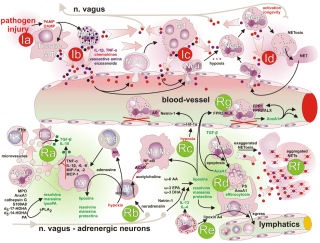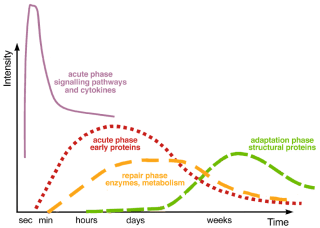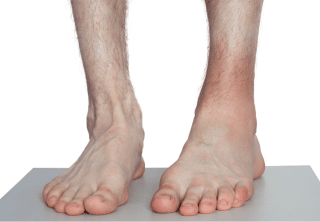Understanding Inflammation

Unless you’ve really been out of the loop, you’ve surely heard inflammation is to blame for almost every known malady. Or at least, that’s what the diet, supplement, and self-help ads claim. But, even if the health-care marketplace has overhyped and oversold inflammation in its relentless search for the next big thing, it’s no exaggeration to say inflammation plays a key role in a wide range of conditions—from depression to tendon pain, fibromyalgia to cancer, and joint problems to aging itself.
There are also bigger questions about the nature and function of inflammation that might influence the way we think and work. What roles do the brain and nervous system play? How do psychosocial factors (such as stress or depression) play into inflammation? Could pain itself be a type of inflammatory response?
Let’s start by reviewing some inflammation basics.
INFLAMMATION IS GOOD
Inflammation is simply the immune system’s tissue protection and repair response. It can be triggered by injury, infection, or irritation. Inflammation is necessary and good: though it can be uncomfortable, without inflammation, the body can’t protect or heal itself. Normally, inflammatory responses are self-limiting, and wind down when their protection and repair tasks are complete.
WHEN INFLAMMATION TURNS BAD
Problems happen when there is either:
-
- Hypoinflammation, such as when a compromised immune system can’t fight an infection or heal an injury; or
- Hyperinflammation, which can happen when either immune reactions are out of proportion to the threat (as in allergic reactions or autoimmune disorders) or when normal inflammatory reactions don’t resolve and become chronic.
Chronic or unresolved inflammation is implicated in an ever-lengthening list of conditions, including asthma, Alzheimer’s, depression and mental illness, hypersensitivities, rheumatoid arthritis, metabolic syndrome, and certain cancers. Inflammation is not only a factor in nearly all chronic diseases, but also in nearly all musculoskeletal complaints, including chronic pain.
PROGRESSION OF INFLAMMATION
Healthy inflammatory responses progress over time, moving through acute, repair, and adaptation phases (Image 2). Though many of these functions happen simultaneously (for example, resolution processes begin even while inflammatory processes are in their early development), each step sets the stage for the next.
ACUTE RESPONSE
Within seconds or minutes after damage, danger, or pathogen detectors trigger an acute inflammatory response, proinflammatory histamine and kinins increase vascular and cell permeability, and the affected tissues swell with plasma and immune cells (such as leukocytes). Cytokines (signaling proteins) recruit roaming immune cells; local warmth and redness (Image 3) indicate that the active inflammatory responses are at work; and pain and tenderness (from nociceptor irritation by proinflammatories, pressure from swelling, and protective reactions) help guard against further strain or mechanical distress during this initial phase.
REPAIR
Within hours or days, specialized cells (such as mononuclear cells and macrophages) begin the process of degrading and removing damaged or diseased cells. Once unleashed, these destructive processes are kept in check by innate anti-inflammatory and pro-resolution mechanisms to minimize “bystander” damage to other tissues. Simultaneously, fibroblasts (which themselves have strong anti-inflammatory capacities) and other cells begin new tissue formation. Local warmth and redness diminish, as does pain—though pressure or stretch can still provoke protective tenderness as the new tissues form.
ADAPTATION
In the days, weeks, or months that follow, the proinflammatory process gradually matures and diminishes as the first-responder cells themselves become the target of degradation and cleanup via phagocytic, lymphatic, and other resolution mechanisms. Tissue strengthening continues, as fibroblasts cross-link collagen structures. Sensation normalizes and tenderness diminishes as the adapting brain gradually reevaluates and relinquishes the need for protective guarding.
- IMAGE 1.
- IMAGE 2.
- IMAGE 3.
Normally, inflammation progresses through acute, intermediate (repair), and later (adaptation) stages, each with its own mechanisms and processes (see text). When any stage’s progression is inhibited or prolonged, inflammation can become chronic. Resolution timelines vary tremendously, depending on the individual, the tissue, or the organ involved, etc., with full recovery in some cases taking months or years. After Steinacker et al., 1999, courtesy Advanced-Trainings.com.
CHRONIC INFLAMMATION
Problems arise when any of these stages fails to resolve, and the inflammation becomes ongoing or chronic. This can happen when the immune system is overwhelmed by pathogens or damage, or when its resilience is taxed by stress, inactivity, diet, lack of sleep, etc. Factors such as adverse childhood experiences4 or genetics can also predispose us to chronic inflammation. But the causes of many chronic inflammatory conditions are not fully understood. These include autoimmune disorders, such as rheumatoid arthritis; fibromyalgia; and “inflamm-aging,” the low-grade inflammation-like changes that accompany aging.
In prolonged inflammation:
-
- Fibroblasts, which usually have strong anti-inflammatory effects, can instead play an inflammatory role. Together with myofibroblasts, their unregulated activity over time can cause tissue fibrosis, stiffening, and pathologic scarring.
- Treatment-resistant depression is more common, supporting the idea that some depression has inflammatory causes.
- Pain can be persistent and difficult to treat. A recent study found that pain sufferers who didn’t respond to other forms of therapy had higher levels of chronic inflammation, suggesting (though not confirming) that inflammation can directly trigger persistent pain responses
Now that you have a better understanding of inflammation; keep an eye out NEXT WEEK for the next article “UNDERSTANDING INFLAMMATION AND PAIN” where I talk about how inflammation causes pain in both chronic and acute conditions.
If you have any questions or concerns about your inflammation or condition, please reach out to us at 519-735-7555.





